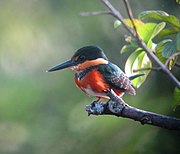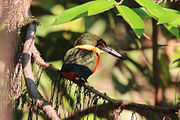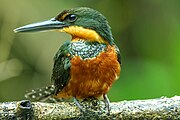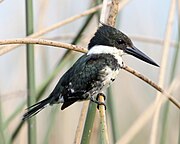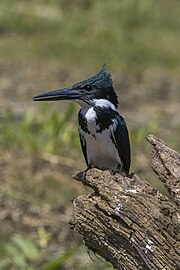American green kingfisher
| American green kingfishers | |
|---|---|
 | |
| Green-and-rufous kingfisher in Bolivia | |
| Scientific classification | |
| Domain: | Eukaryota |
| Kingdom: | Animalia |
| Phylum: | Chordata |
| Class: | Aves |
| Order: | Coraciiformes |
| Family: | Alcedinidae |
| Subfamily: | Cerylinae |
| Genus: | Chloroceryle Kaup, 1848 |
| Type species | |
| Alcedo superciliosa[1] =Alcedo aenea Linnaeus, 1766 | |
| Species | |
| C. amazona | |
| Phylogeny | |||||||||||||||||||||
| |||||||||||||||||||||
| Cladogram based on Andersen et al. (2017)[2] |
The American green kingfishers are the kingfisher genus Chloroceryle, which are native to tropical Central and South America, with one species extending north to south Texas.
Taxonomy and species
The genus Chloroceryle was introduced in 1848 by the German naturalist Johann Jakob Kaup.[3] Kaup did not specify a type species but Richard Bowdler Sharpe designated the American pygmy kingfisher in 1871.[4][5] The genus name combines the Ancient Greek khlōros meaning "green" with the genus Ceryle that was introduced by Friedrich Boie in 1828.[6]
The genus contains four species:[7]
| Common name | Scientific name and subspecies | Range | Size and ecology | IUCN status and estimated population |
|---|---|---|---|---|
| American pygmy kingfisher
| Chloroceryle aenea (Pallas, 1764) | southern Mexico south through Central America to western Ecuador, and then around the northern Andes cordillera in the east to central Bolivia and central Brazil. | Size: Habitat: Diet: | LC
|
| Green-and-rufous kingfisher
| Chloroceryle inda (Linnaeus, 1766) Two subspecies
| Nicaragua to northern Bolivia, southeastern Brazil, western Colombia, northwestern Ecuador | Size: Habitat: Diet: | LC
|
| Green kingfisher
| Chloroceryle americana (Gmelin, JF, 1788) | southern Texas in the United States south through Central and South America to central Argentina. | Size: Habitat: Diet: | LC
|
| Amazon kingfisher
| Chloroceryle amazona (Latham, 1790) | southern Mexico south through Central America to northern Argentina. | Size: Habitat: Diet: | LC
|
The American green kingfishers breed by streams in forests or mangroves, nesting in a long horizontal tunnel made in a river bank.
They have the typical kingfisher shape, with a short tail and long bill. All are plumaged oily green above, and the underpart colour shows an interesting pattern insofar as the smallest and second largest, American pygmy kingfisher and green-and-rufous kingfisher, have rufous underparts, whereas the largest and second smallest, Amazon kingfisher and green kingfisher, have white underparts with only the males also having a rufous breast band.
These birds take crustaceans and fish caught by the usual kingfisher technique of a dive from a perch or brief hover, although the American pygmy kingfisher will hawk at insects in flight.
Evolutionary history
These water kingfishers are descended from a common ancestor which seems to have been closely related to a progenitor of the pied kingfisher (which at that stage had not yet lost the metallic plumage tone), and are similar in plumage and habits (Moyle, 2006). All four have overlapping ranges, and may fish the same waters; however the weight ratio of aenea: americana: inda: amazona is almost exactly 1:2:4:8, which prevents direct competition for food. The ringed kingfisher, Megaceryle torquata, a more distant relative, also occurs on the same rivers, but is twice as heavy as the Amazon kingfisher.
Genetically, the largest species, C. amazona, is the most distantly related, while the medium-sized (but differently colored) C. americana and C. inda are sister species. The differing coloration therefore does not indicate their evolutionary history, but rather seems to have evolved independently, to underscore the visual distinctness between taxa, thus helping to keep their gene pools separate (see also Competitive exclusion principle).
References
- ^ "Alcedinidae". aviansystematics.org. The Trust for Avian Systematics. Retrieved 2023-07-25.
- ^ Andersen, M.J.; McCullough, J.M.; Mauck III, W.M.; Smith, B.T.; Moyle, R.G. (2017). "A phylogeny of kingfishers reveals an Indomalayan origin and elevated rates of diversification on oceanic islands". Journal of Biogeography. 45 (2): 1–13. doi:10.1111/jbi.13139.
- ^ Kaup, Johann Jakob (1848). "Die Familie der Eisvögel (Alcedidae)". Verhandlungen des Naturhistorischen Vereins für das Großherzogthum Hessen und Umgebung (in German). 2: 61–81 [68]. OCLC 183221382.
- ^ Peters, James Lee, ed. (1945). Check-list of Birds of the World. Vol. 5. Cambridge, Massachusetts: Harvard University Press. p. 168.
- ^ Sharpe, R. Bowdler (1868–1871). A Monograph of the Alcedinidae : or, Family of Kingfishers. London: Published by the author. p. viii.
- ^ Jobling, James A. (2010). The Helm Dictionary of Scientific Bird Names. London: Christopher Helm. p. 102. ISBN 978-1-4081-2501-4.
- ^ Gill, Frank; Donsker, David, eds. (August 2022). "Rollers, ground rollers & kingfishers". World Bird List Version 12.2. International Ornithologists' Union. Retrieved 2 January 2023.
- ffrench, Richard (1991). A Guide to the Birds of Trinidad and Tobago (2nd ed.). Comstock Publishing. ISBN 0-8014-9792-2.
- Fry, K & Fry, H. C. (2000): Kingfishers, Bee-eaters and Rollers. ISBN 0-7136-5206-3
- Hilty, Steven L (2003). Birds of Venezuela. London: Christopher Helm. ISBN 0-7136-6418-5.
- Moyle, Robert G. (2006). "A Molecular Phylogeny of Kingfishers (Alcedinidae) With Insights into Early Biogeographic History". Auk. 123 (2): 487–499. doi:10.1642/0004-8038(2006)123[487:AMPOKA]2.0.CO;2. hdl:1808/16596.
- v
- t
- e
- Kingdom: Animalia
- Phylum: Chordata
- Class: Aves
- Order: Coraciiformes
- Family: Alcedinidae
- Subfamily: Cerylinae
- Giant kingfisher (M. maxima)
- Crested kingfisher (M. lugubris)
- Belted kingfisher (M. alcyon)
- Ringed kingfisher (M. torquata)
- Pied kingfisher (C. rudis)
- Amazon kingfisher (C. amazona)
- Green kingfisher (C. americana)
- Green-and-rufous kingfisher (C. inda)
- American pygmy kingfisher (C. aenea)

